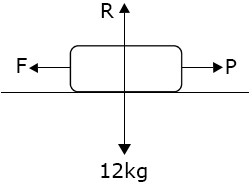Force can be defined as that which changes or tends to change the state of rest or uniform motion of a body. Force is a vector quantity and the S.I unit is Newton.
Force can cause a body at rest to move, it causes a moving object to accelerate, change direction, move in a curved path e.t.c.
There are two types of forces, namely contact force and force field. Contact force is a force that exists between bodies by virtue of their contact. They are push, pull, normal reaction, tension in strings, wires or frictional force.
Force field/Non-contact force is the force that exists within a vector field such as gravitational field, magnetic field, Electric field, nuclear field. The forces are gravitational force, magnetic force, electrostatic force and nuclear force.
This is the force of attraction with which a planet attracts any object towards its centre or the force of attraction between any two masses. The earth is a gravitational field.
This is a force that exist round a charged body. The charged body could be positively charged or negatively charged.
This is a force that exist around a magnet. A magnet always have the North pole and the South pole
Nuclear force:
This is the force of attraction which holds the protons and neutrons in the nucleus of an atom.
Friction can be defined as the force that opposes the relative motion between any two surfaces in contact. There can be solid friction or fluid friction. Fluid friction is also called viscosity.
It acts whenever there is motion or tendency for something to move. i.e friction (or frictional force) is absent if there is no motion or if there is no force intending to cause motion.It stops your car when the brake is applied. It prevents your foot from slipping backward when you walk.
There are two types of frictional force
EVALUATION
It is directly proportional to the perpendicular force (normal reaction) between the two surfaces.(R is the perpendicular force between the two surfaces in contact)
F α R
F = µR
F – Frictional force, R – normal reaction, µ – coefficient of static friction
Note that R = W for bodies on horizontal surfaces
It is defined as the ratio of the frictional force to the normal reaction force between two surfaces. A high coefficient of friction implies that a large force is required to cause movement.
Question: A crate solid down an inclined plane such that the frictional force opposing its motion is 40N. If the normal reaction of the plane on the crate is 50N, calculate the coefficient of dynamic friction.
Solution: Frictional force F = 40N
Normal reaction R = 50N
Coefficient of friction µ= ?
F = µR
40 = µ × 50 (dividing both sides by 50)
4050 = µ
µ = 0.8
µ = 0.8
Question B. A block of mass 12kg rests on a horizontal floor, coefficient of friction is 0.35. Determine the minimum force required to move the block when pulling horizontally. (g = 10m/s2)

Solution
W = mg = 12 × 10 = 120N, W = R = 120N
Where W – weight of the body, m – mass of the body, g is acceleration due to gravity and R is the normal reaction
F = µR
F = P = µR = 120 × 0.35 = 42.0N
Question C. A metal block of mass 5kg lies on a rough horizontal platform. If a horizontal force of 8N applied to the block through its center of mass just slides the block on the platform. Calculate the coefficient of limiting friction between the block and the platform. ( g = 10m/s2).
Question D. A wooden block whose weight is 50N rests on a rough horizontal plane surface. If the limiting friction is 20N. Calculate the coefficient of static friction.
EVALUATION
Due to the disadvantages of friction mentioned above, it is often necessary to reduce friction in machines. This is possible through any of the following methods:
GENERAL EVALUATION
Take the coefficient of friction between the box and the surface as 0.25 and g = 10m/s2.
Read our disclaimer.
AD: Take Free online baptism course: Preachi.com 